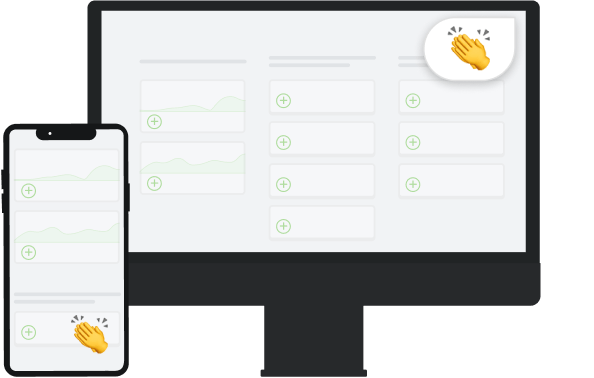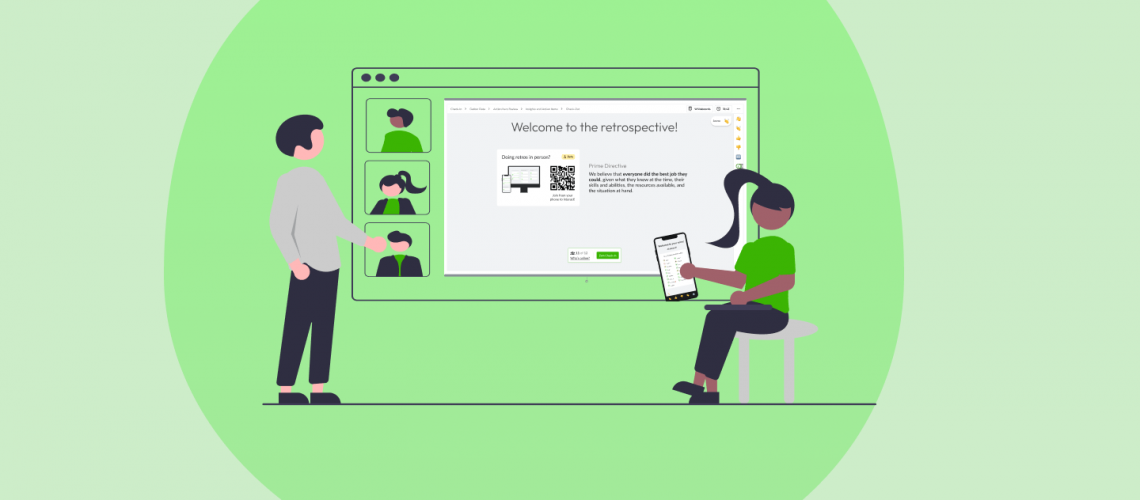Many teams worked completely remotely or in the home office during the Corona pandemic. Some companies are slowly going "back to office" or into a hybrid working model: some are on site, others in the home office. Since the timing and "how" is often unclear, the retro formats in hybrid teams are also difficult to plan. So how can Agile Coaches and Scrum Masters best design retrospectives in hybrid, on-site or remote setups?
Here we summarize the main differences and tips for the retro methods and formats.
🔮 The numbers & outlook for hybrid work in agile teams
- Only 3 % say they plan to return to the office full-time
- 25 % respondents say they will continue to work fully remotely even in a post-COVID world
- 56 % prefer a hybrid approach, returning to the office regularly but not daily
Simply effective retros - whether from a laptop or smartphone
Share live reactions 👋, Participate in live surveys 🎚, write feedbacks 💬, vote for topics 👍 , & more

☝️ Tip 1: Clarify the setup of the retro in advance
What many are not aware of, but has proven itself again and again in traditional hybrid remote organizations like Gitlab: The best setup for “hybrid working” is to set up all communication “remote first”.
So if you have a team with members who work remote, it pays off to do all of the communication and documentation “remote first” right away. This may seem costly in the short term, but it pays off in the long run.
So if your team decides to go hybrid, make sure you do it right. For an agile team, this means that the retrospectives must also meet this "remote first" claim.
But what if some colleagues are on site at the retros and others are remote?
☝️ Tip 2: Equal interaction for remote and on-site participants
Retro Method 1: All participants dial in separately
With this retro method, all team members simply take part in the online meeting separately, including the team members who are on site in the office and who could theoretically meet together in one room. So the same setup is given for all participants. Why not put all colleagues in the office in a conference room? Because that creates a two-class dynamic in which the remote colleagues are excluded from many interactions in the room. Anyone who has tried this “partially in the room, partly via video conference” setup knows what we are talking about here.Retro method 2: Use digital channel also for on-site colleagues
Even if method 1 is the preferred variant according to the "remote first" logic, we at least don't want to deprive you of method 2: If you have part of the team together in one room, it is at least important to make the interaction as equal as possible for everyone. A physical whiteboard is therefore unsuitable for this. The better alternatives are online whiteboards (like Miro), live engagement tools (like Mentimeter), or simply Echometer – which combines whiteboard and live engagement functionalities. Basically, it should also be ensured that the retro format (“Keep, Stop, Start”, etc.) is conceivable for a distributed team. Here you will find more relevant creative retrospective methods such as Skribbl or the Johari window.☝️ Tip 3 for retrospectives in hybrid teams: involve the team in the design
This tip is obvious, but is often neglected: simply ask the team openly how they imagine the hybrid retrospectives to be. As a Scrum Master or Agile Coach, you are not solely responsible for the retro method, but the team as a whole.
What works great in this context in both remote, hybrid and on-site retrospectives: In the check-out of the retrospective, ask the “Return on Time Invest” (ROTI for short) on a scale from 0 (very poorly invested time) to 10 ( time well spent) and ask why the rating was given. In this way you create a framework right at the end of the retro to take in the fresh impressions of the team.
Most Agile Coaches and Scrum Masters run in circles...
...fixing superficial symptoms. Time to use psychology to foster sustainable mindset change.
☝️ Tip 4: One platform for all retro setups (remote, hybrid and on-site)
In the spirit of “remote first”, there should be a digital retro archive that all colleagues can access.
This should document on-site retros, hybrid retros, and complete remote retros alike.
This documentation will be very helpful to visualize the development of the team over time. Frequently after viewing older retros we have heard things like “Wow, that was really our biggest challenge a year ago?”
Corresponding moments of success have a great effect on making the added value of agile methods tangible and thus increasing the commitment to retros.
With Echometer there is a platform that supports all hybrid retro formats from preparation, implementation to post-processing.
With Echometer you can:
- Obtain feedback via a survey in advance and asynchronously to the retrospective
- Get feedback live during the retro and start voting – NEW: this is now even possible for the participants via their smartphone
- You automatically get a ROTI for every retrospective and see how the quality of the different formats is perceived
- And last but not least, you have a uniform documentation of all your retrospectives included at the push of a button
The uniform platform makes team development more transparent for everyone involved and the team only has one holistic solution for continuous team development instead of different tools.
By the way, you can conduct a retrospective with our tool without having to register. Use this button to try out a retrospective on the 5 agile Scrum values:
Note: This retrospective format asks for agreement with the given Health Check items on a scale.
- Courage: We value people showing courage.
- Respect: We value each other’s ideas, even when disagreeing.
- Commitment: Every team member is committed to follow through on what they have promised.
- Focus: We don’t allow ourselves to be distracted from reaching the sprint goal.
- Openness: We are open to constructive feedback and grow from it.
If you are searching for fun retrospective ideas, check out our post on 54 Kickass Retrospective Ideas for Agile Teams (including the Mario Kart Retro & the Team Morale Health Check).













